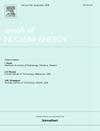基于GAN-IAAKR模型的核电站传感器异常检测与故障定位研究
IF 1.9
3区 工程技术
Q1 NUCLEAR SCIENCE & TECHNOLOGY
引用次数: 0
摘要
解决核电站传感器在微小漂移和精度退化故障下的准确异常检测问题,以及核电传感器故障定位算法缺乏数据方向性、模型鲁棒性和实时性等问题。本文提出了一种基于gan - iaakr的传感器异常检测与故障定位方法,以准确、及时地检测出核电站传感器故障时的异常状态,并对故障传感器进行故障定位。首先,采用时间序列二维化方法将正常传感器监测数据编码为图像;接下来,利用进化博弈论,将多个生成器和判别器组织成两个不同的群体,同时参与游戏。在博弈过程中,建立复制器动态方程,通过平滑机制动态调整每个生成器和鉴别器的权重。然后将编码后的图像输入到增强的GAN模型中进行训练。在此基础上,GAN模型重建图像,通过计算原始图像与重建图像之间的MSE统计量(重建误差)进行异常检测。最后,应用改进的AAKR算法对传感器监测数据进行重构。通过设置重构误差阈值,可以有效区分正常和异常数据,从而实现故障定位。通过实验比较了One-Class SVM、Autoencoder和GAN模型在轻微漂移和精度退化故障条件下的异常检测性能。实验结果表明,所提出的异常检测模型具有较高的检测准确率,达到95%以上,故障定位模型也具有较高的准确性、实时性和鲁棒性,准确率超过90%。本文章由计算机程序翻译,如有差异,请以英文原文为准。
Research on sensor anomaly detection and fault location in nuclear power plants based on GAN-IAAKR model
To address the issues of accurate anomaly detection under minor drift and accuracy degradation faults in nuclear power plant sensors, as well as the lack of data directionality, model robustness, and real-time performance in fault localization algorithms for nuclear power sensors. A GAN-IAAKR-based method for sensor anomaly detection and fault localization is proposed in this paper to accurately and promptly detect anomalous states in nuclear power plant sensors during faults and to perform fault localization for the faulty sensors First, a time-series two-dimensionalization method is employed to encode normal sensor monitoring data into images. Next, evolutionary game theory is utilized, where multiple generators and discriminators are organized into two distinct groups to simultaneously engage in the game. During the game, a replicator dynamic equation is established, and the weights of each generator and discriminator are dynamically adjusted through a smoothing mechanism. The encoded images are then fed into an enhanced GAN model for training. Building on this, the GAN model reconstructs the images, and anomaly detection is carried out by calculating the MSE statistic (reconstruction error) between the original and the reconstructed images. Finally, the improved AAKR algorithm is applied to reconstruct the sensor monitoring data. By setting a reconstruction error threshold, normal and anomalous data can be effectively differentiated, thereby enabling fault localization. Experiments were conducted to compare anomaly detection performance between One-Class SVM, Autoencoder, and GAN models under conditions of minor drift and accuracy degradation faults. The experimental results demonstrate that the proposed anomaly detection model exhibits a high detection accuracy, exceeding 95%, while the fault localization models also show superior accuracy, real-time performance, and robustness, with an accuracy rate exceeding 90%.
求助全文
通过发布文献求助,成功后即可免费获取论文全文。
去求助
来源期刊

Annals of Nuclear Energy
工程技术-核科学技术
CiteScore
4.30
自引率
21.10%
发文量
632
审稿时长
7.3 months
期刊介绍:
Annals of Nuclear Energy provides an international medium for the communication of original research, ideas and developments in all areas of the field of nuclear energy science and technology. Its scope embraces nuclear fuel reserves, fuel cycles and cost, materials, processing, system and component technology (fission only), design and optimization, direct conversion of nuclear energy sources, environmental control, reactor physics, heat transfer and fluid dynamics, structural analysis, fuel management, future developments, nuclear fuel and safety, nuclear aerosol, neutron physics, computer technology (both software and hardware), risk assessment, radioactive waste disposal and reactor thermal hydraulics. Papers submitted to Annals need to demonstrate a clear link to nuclear power generation/nuclear engineering. Papers which deal with pure nuclear physics, pure health physics, imaging, or attenuation and shielding properties of concretes and various geological materials are not within the scope of the journal. Also, papers that deal with policy or economics are not within the scope of the journal.
 求助内容:
求助内容: 应助结果提醒方式:
应助结果提醒方式:


